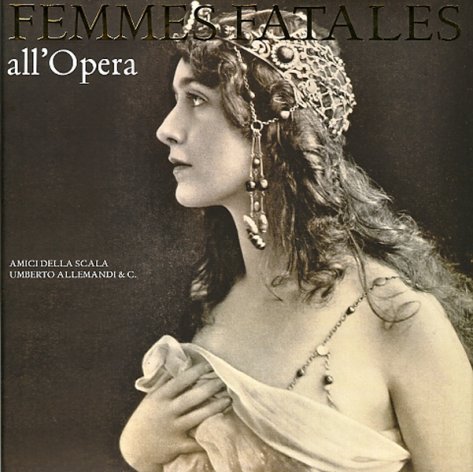‹ Collection 'Sette dicembre' ›
Femmes fatales at the Opera
by Vittoria Crespi Morbio.
Essays by Vittoria Crespi Morbio (Carmen in furs); Quirino Principe, André Tubeuf.
Appendices: Femmes fatales at La Scala by Andrea Vitalini.
Collection «December Seventh».
Umberto Allemandi&C / Amici della Scala, Torino 2009.
Italian and English edition, pp.212.
The «belle dame sans merci» as personified in the poem by Keats, the seductress who drives men insane and slowly but surely to their ruin, is one of the myths of modern culture, pervading literature, drama, figurative arts, cinema. In opera the «femme fatale» is an archetype en compassing the magicians of antique phantasmagorias like Alcina and Armida, as well as Carmen, Salome, and most representative of all, Lulu, who wraps in her lethal coils all the men she meets, finally succumbing to Jack the Ripper’s blade.
A painstaking study of the figures of the great singers, carried out at the most famous opera theatres in the word, assembled in the book the most stunning pictures of the enchantresses in music, who forever will outpour charm and poison, beauty and perdition, over all those are fated to love them.
WAGNER alla Scala / WAGNER at La Scala
Edited by Vittoria Crespi Morbio.
Essays by Vittoria Crespi Morbio (Un labirinto per Wagner / A Labyrinth for Wagner); Franco Serpa.
Appendix: Wagner at La Scala from 1873 to 2007 by Andrea Vitalini.
Collection «December Seventh»
Amici della Scala, Milan 2007.
Italian - English edition, pp. 132.
Link to buy it: http://lascalashop.it/searchresultp.asp
Toscanini made his debut at La Scala in 1899 with Die Meistersinger von Nürnberg and on behalf of Wagner backed the famous reforms which produced the recessed orchestra pit and the construction of the ‘mystic gulf’; this was followed by the historical productions of the Wagnerian repertory conducted by masters including Antonio Guarnieri, Wilhelm Furtwaengler, Victor de Sabata, Gino Marinuzzi, Clemens Krauss, Herbert von Karajan, Karl Böhm.
According to Wagner’s conception opera had to be recast as a “total work of art”: a perfect blending of words, music, scenic gestures, images. Only in this way would the theatre be redeemed, liberated from the decorative role in which modern society relegated it, and be able to express through myth the concept of “purely human”, meaning human nature as such.
Wagner devoted many theoretic works to this ideal, his thinking perpetually evolving, as the musical scores show us. In a few words we might say that after the first works, still tied to the obligation to represent on the stage situations, men, things, objects, historic and geographic events, Wagner gradually relinquished the notion of the theatre. The magic vessel of Der fliegende Holländer gave way to the knightly and romantic world of Tannhäuser and Lohengrin and then to the pure elements of the Ring (fire, water, the arcane seat of the gods), from the supreme interiority of Tristan und Isolde to the mystical ceremonial of Parsifal. With this last work the representative theatre was reabsorbed in a ritual, conceptual one, foreshadowing the abstract art of the twentieth century.
On the stage of La Scala, the greatest artists and scenographers devoted their talent to Wagner’s genius: Adolphe Appia, probably the most famous and innovative Wagnerian director, celebrated painters (Casorati, Sironi, Marussig, Oppo), great decorators and set designers of our time (Giorgio Strehler, Luca Ronconi, Nikolaus Lehnhoff, Richard Peduzzi, Patrice Chéreau).
A tribute to Wagner through the history of the scenographies at La Scala provides the opportunity to enter in a world that revolutionised the conception of the modern theatre.
› Categoria: ‹ Collection 'Sette dicembre' › ‹ books ›
